Toyota's Logistics and Supply Chain Analysis: A Case Study
VerifiedAdded on 2023/04/19
|16
|3283
|360
Essay
AI Summary
This essay provides an in-depth analysis of Toyota's supply chain management, focusing on its operations in the UK. It explores the company's business relationships with suppliers, examining how Toyota fosters collaboration and maintains strong partnerships through strategies like single-sourcing and vendor development. The essay also delves into Toyota's logistics mix, including transportation networks, inventory management approaches like Just-in-Time (JIT), and lean production processes. The analysis highlights how Toyota uses a 'market minus approach' to pricing and emphasizes the importance of efficient information and money flow within its supply chain. The study underscores Toyota's commitment to continuous improvement, flexibility, and maintaining long-term relationships with its suppliers to achieve cost efficiency, quality, and customer satisfaction.
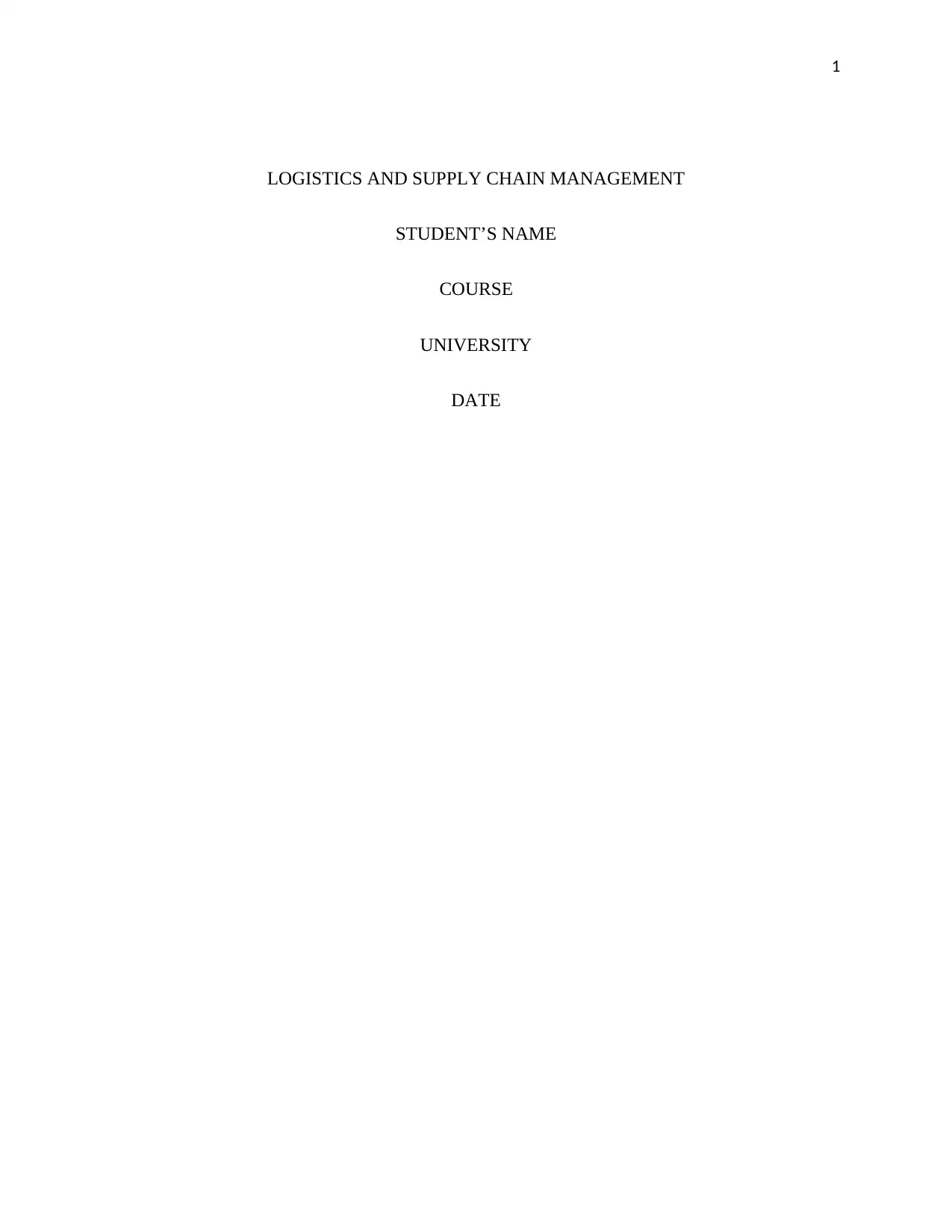
1
LOGISTICS AND SUPPLY CHAIN MANAGEMENT
STUDENT’S NAME
COURSE
UNIVERSITY
DATE
LOGISTICS AND SUPPLY CHAIN MANAGEMENT
STUDENT’S NAME
COURSE
UNIVERSITY
DATE
Paraphrase This Document
Need a fresh take? Get an instant paraphrase of this document with our AI Paraphraser
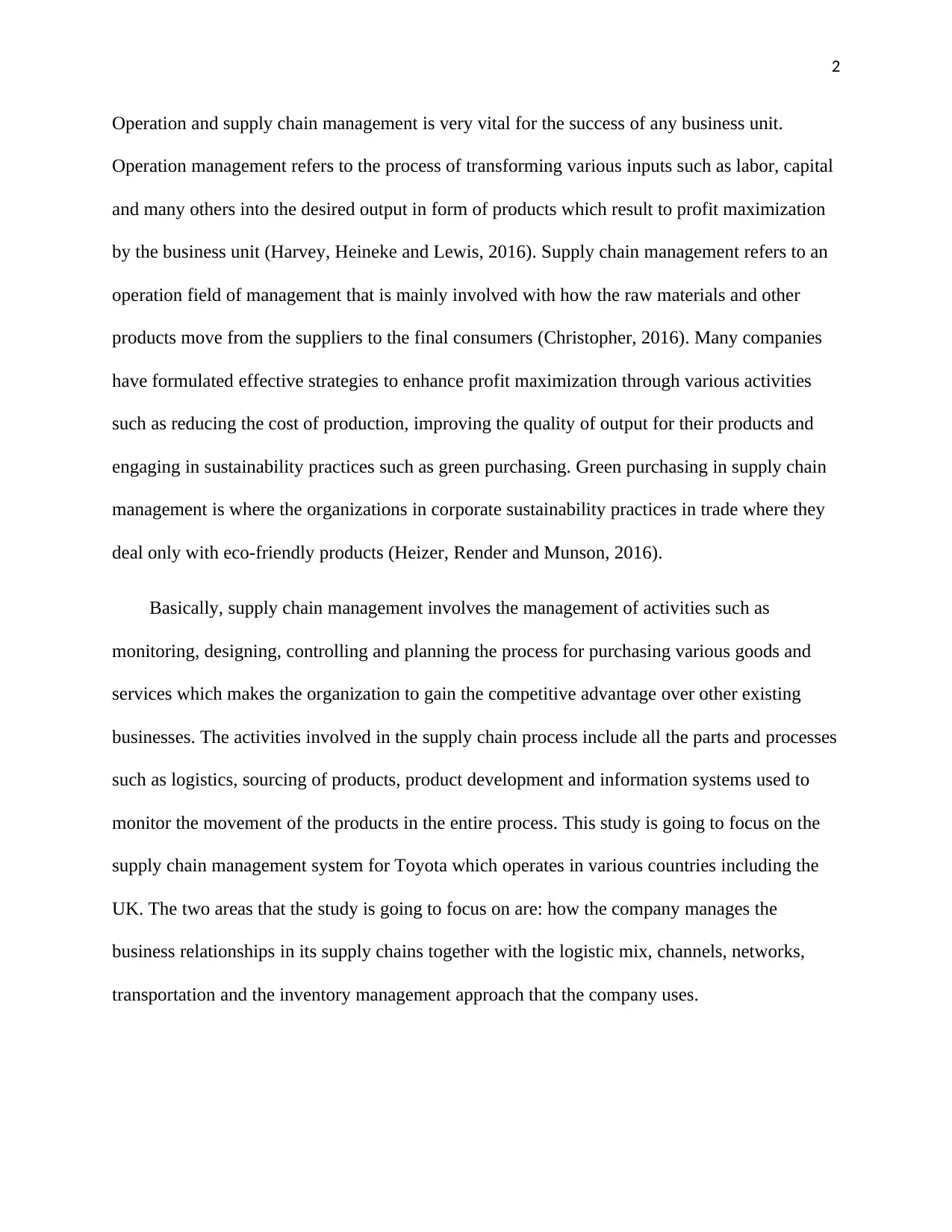
2
Operation and supply chain management is very vital for the success of any business unit.
Operation management refers to the process of transforming various inputs such as labor, capital
and many others into the desired output in form of products which result to profit maximization
by the business unit (Harvey, Heineke and Lewis, 2016). Supply chain management refers to an
operation field of management that is mainly involved with how the raw materials and other
products move from the suppliers to the final consumers (Christopher, 2016). Many companies
have formulated effective strategies to enhance profit maximization through various activities
such as reducing the cost of production, improving the quality of output for their products and
engaging in sustainability practices such as green purchasing. Green purchasing in supply chain
management is where the organizations in corporate sustainability practices in trade where they
deal only with eco-friendly products (Heizer, Render and Munson, 2016).
Basically, supply chain management involves the management of activities such as
monitoring, designing, controlling and planning the process for purchasing various goods and
services which makes the organization to gain the competitive advantage over other existing
businesses. The activities involved in the supply chain process include all the parts and processes
such as logistics, sourcing of products, product development and information systems used to
monitor the movement of the products in the entire process. This study is going to focus on the
supply chain management system for Toyota which operates in various countries including the
UK. The two areas that the study is going to focus on are: how the company manages the
business relationships in its supply chains together with the logistic mix, channels, networks,
transportation and the inventory management approach that the company uses.
Operation and supply chain management is very vital for the success of any business unit.
Operation management refers to the process of transforming various inputs such as labor, capital
and many others into the desired output in form of products which result to profit maximization
by the business unit (Harvey, Heineke and Lewis, 2016). Supply chain management refers to an
operation field of management that is mainly involved with how the raw materials and other
products move from the suppliers to the final consumers (Christopher, 2016). Many companies
have formulated effective strategies to enhance profit maximization through various activities
such as reducing the cost of production, improving the quality of output for their products and
engaging in sustainability practices such as green purchasing. Green purchasing in supply chain
management is where the organizations in corporate sustainability practices in trade where they
deal only with eco-friendly products (Heizer, Render and Munson, 2016).
Basically, supply chain management involves the management of activities such as
monitoring, designing, controlling and planning the process for purchasing various goods and
services which makes the organization to gain the competitive advantage over other existing
businesses. The activities involved in the supply chain process include all the parts and processes
such as logistics, sourcing of products, product development and information systems used to
monitor the movement of the products in the entire process. This study is going to focus on the
supply chain management system for Toyota which operates in various countries including the
UK. The two areas that the study is going to focus on are: how the company manages the
business relationships in its supply chains together with the logistic mix, channels, networks,
transportation and the inventory management approach that the company uses.
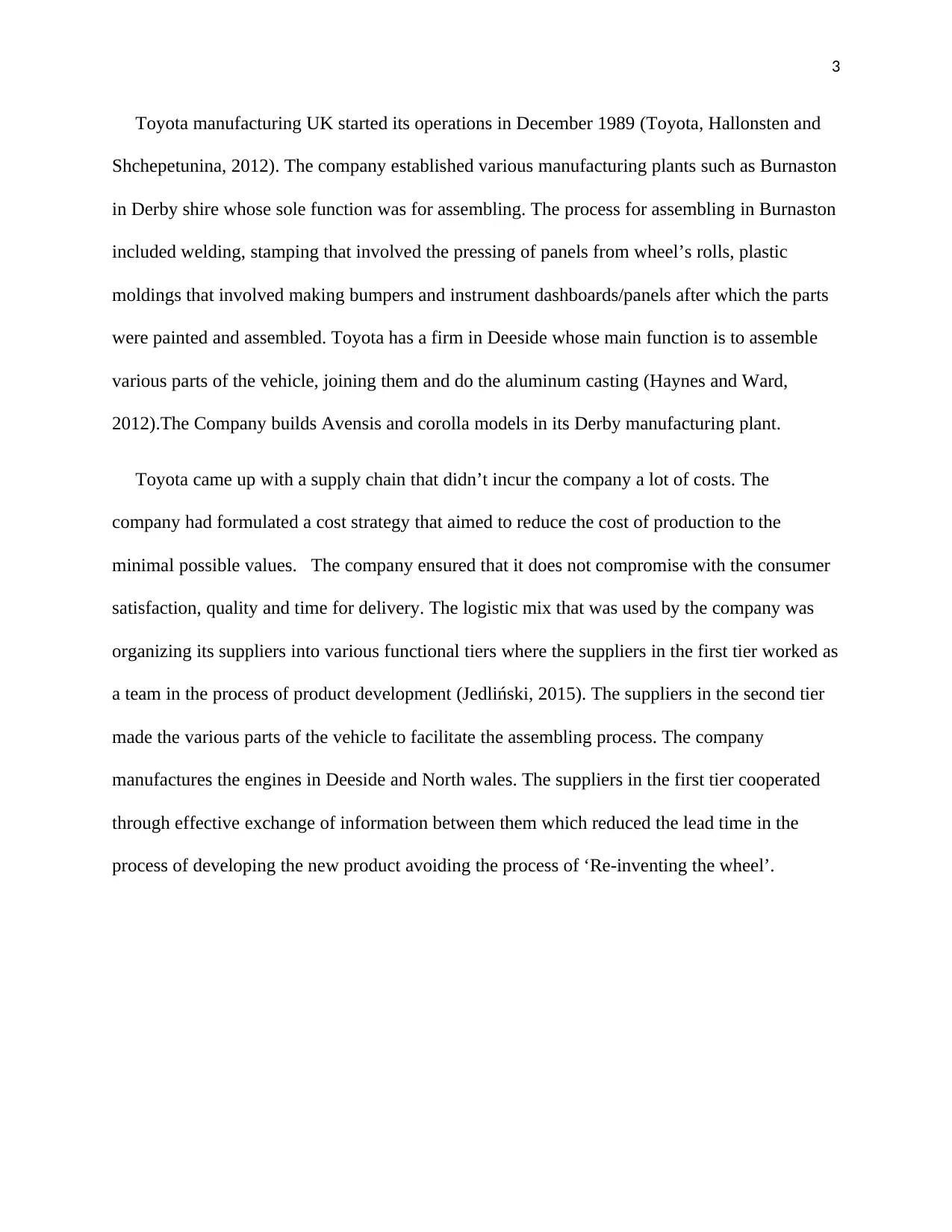
3
Toyota manufacturing UK started its operations in December 1989 (Toyota, Hallonsten and
Shchepetunina, 2012). The company established various manufacturing plants such as Burnaston
in Derby shire whose sole function was for assembling. The process for assembling in Burnaston
included welding, stamping that involved the pressing of panels from wheel’s rolls, plastic
moldings that involved making bumpers and instrument dashboards/panels after which the parts
were painted and assembled. Toyota has a firm in Deeside whose main function is to assemble
various parts of the vehicle, joining them and do the aluminum casting (Haynes and Ward,
2012).The Company builds Avensis and corolla models in its Derby manufacturing plant.
Toyota came up with a supply chain that didn’t incur the company a lot of costs. The
company had formulated a cost strategy that aimed to reduce the cost of production to the
minimal possible values. The company ensured that it does not compromise with the consumer
satisfaction, quality and time for delivery. The logistic mix that was used by the company was
organizing its suppliers into various functional tiers where the suppliers in the first tier worked as
a team in the process of product development (Jedliński, 2015). The suppliers in the second tier
made the various parts of the vehicle to facilitate the assembling process. The company
manufactures the engines in Deeside and North wales. The suppliers in the first tier cooperated
through effective exchange of information between them which reduced the lead time in the
process of developing the new product avoiding the process of ‘Re-inventing the wheel’.
Toyota manufacturing UK started its operations in December 1989 (Toyota, Hallonsten and
Shchepetunina, 2012). The company established various manufacturing plants such as Burnaston
in Derby shire whose sole function was for assembling. The process for assembling in Burnaston
included welding, stamping that involved the pressing of panels from wheel’s rolls, plastic
moldings that involved making bumpers and instrument dashboards/panels after which the parts
were painted and assembled. Toyota has a firm in Deeside whose main function is to assemble
various parts of the vehicle, joining them and do the aluminum casting (Haynes and Ward,
2012).The Company builds Avensis and corolla models in its Derby manufacturing plant.
Toyota came up with a supply chain that didn’t incur the company a lot of costs. The
company had formulated a cost strategy that aimed to reduce the cost of production to the
minimal possible values. The company ensured that it does not compromise with the consumer
satisfaction, quality and time for delivery. The logistic mix that was used by the company was
organizing its suppliers into various functional tiers where the suppliers in the first tier worked as
a team in the process of product development (Jedliński, 2015). The suppliers in the second tier
made the various parts of the vehicle to facilitate the assembling process. The company
manufactures the engines in Deeside and North wales. The suppliers in the first tier cooperated
through effective exchange of information between them which reduced the lead time in the
process of developing the new product avoiding the process of ‘Re-inventing the wheel’.
⊘ This is a preview!⊘
Do you want full access?
Subscribe today to unlock all pages.

Trusted by 1+ million students worldwide
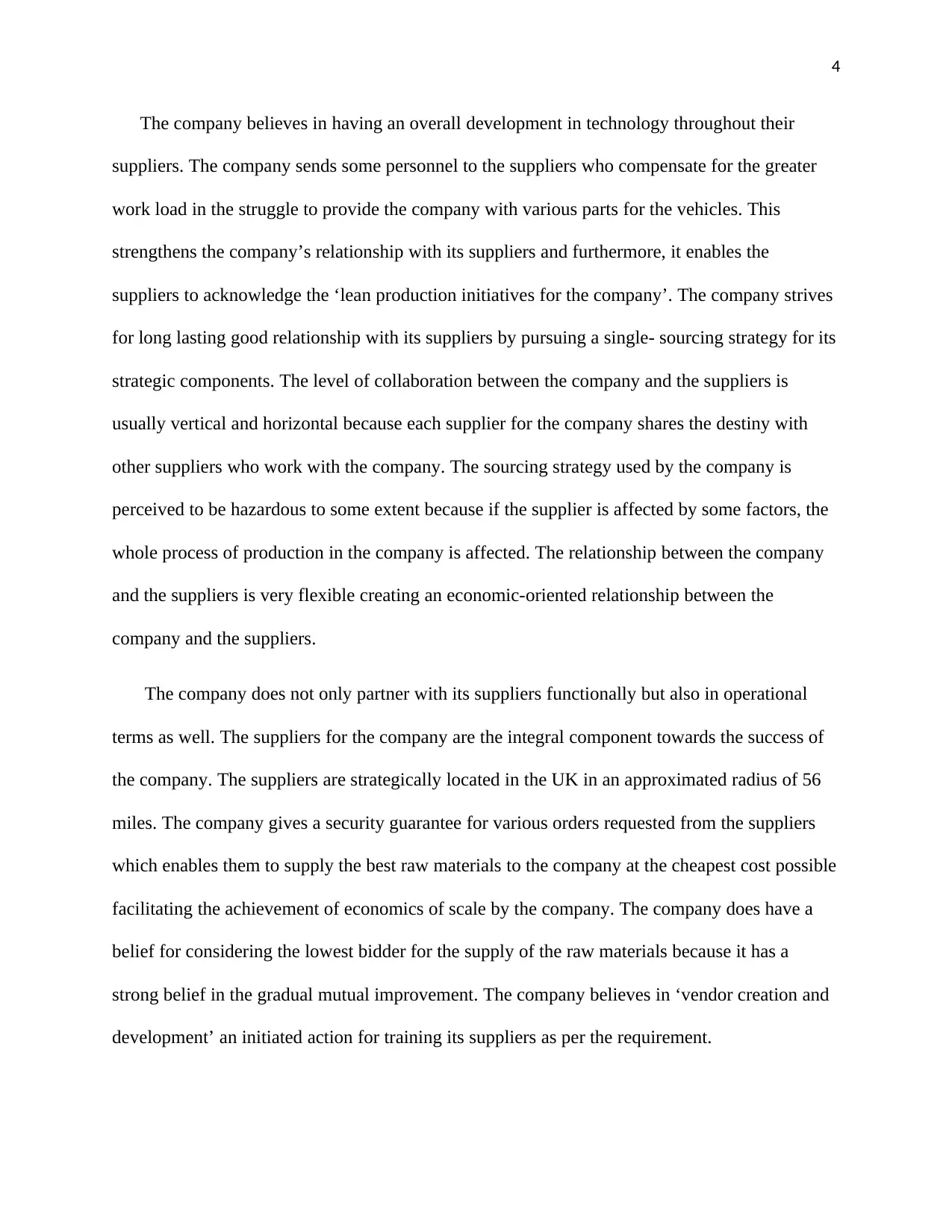
4
The company believes in having an overall development in technology throughout their
suppliers. The company sends some personnel to the suppliers who compensate for the greater
work load in the struggle to provide the company with various parts for the vehicles. This
strengthens the company’s relationship with its suppliers and furthermore, it enables the
suppliers to acknowledge the ‘lean production initiatives for the company’. The company strives
for long lasting good relationship with its suppliers by pursuing a single- sourcing strategy for its
strategic components. The level of collaboration between the company and the suppliers is
usually vertical and horizontal because each supplier for the company shares the destiny with
other suppliers who work with the company. The sourcing strategy used by the company is
perceived to be hazardous to some extent because if the supplier is affected by some factors, the
whole process of production in the company is affected. The relationship between the company
and the suppliers is very flexible creating an economic-oriented relationship between the
company and the suppliers.
The company does not only partner with its suppliers functionally but also in operational
terms as well. The suppliers for the company are the integral component towards the success of
the company. The suppliers are strategically located in the UK in an approximated radius of 56
miles. The company gives a security guarantee for various orders requested from the suppliers
which enables them to supply the best raw materials to the company at the cheapest cost possible
facilitating the achievement of economics of scale by the company. The company does have a
belief for considering the lowest bidder for the supply of the raw materials because it has a
strong belief in the gradual mutual improvement. The company believes in ‘vendor creation and
development’ an initiated action for training its suppliers as per the requirement.
The company believes in having an overall development in technology throughout their
suppliers. The company sends some personnel to the suppliers who compensate for the greater
work load in the struggle to provide the company with various parts for the vehicles. This
strengthens the company’s relationship with its suppliers and furthermore, it enables the
suppliers to acknowledge the ‘lean production initiatives for the company’. The company strives
for long lasting good relationship with its suppliers by pursuing a single- sourcing strategy for its
strategic components. The level of collaboration between the company and the suppliers is
usually vertical and horizontal because each supplier for the company shares the destiny with
other suppliers who work with the company. The sourcing strategy used by the company is
perceived to be hazardous to some extent because if the supplier is affected by some factors, the
whole process of production in the company is affected. The relationship between the company
and the suppliers is very flexible creating an economic-oriented relationship between the
company and the suppliers.
The company does not only partner with its suppliers functionally but also in operational
terms as well. The suppliers for the company are the integral component towards the success of
the company. The suppliers are strategically located in the UK in an approximated radius of 56
miles. The company gives a security guarantee for various orders requested from the suppliers
which enables them to supply the best raw materials to the company at the cheapest cost possible
facilitating the achievement of economics of scale by the company. The company does have a
belief for considering the lowest bidder for the supply of the raw materials because it has a
strong belief in the gradual mutual improvement. The company believes in ‘vendor creation and
development’ an initiated action for training its suppliers as per the requirement.
Paraphrase This Document
Need a fresh take? Get an instant paraphrase of this document with our AI Paraphraser
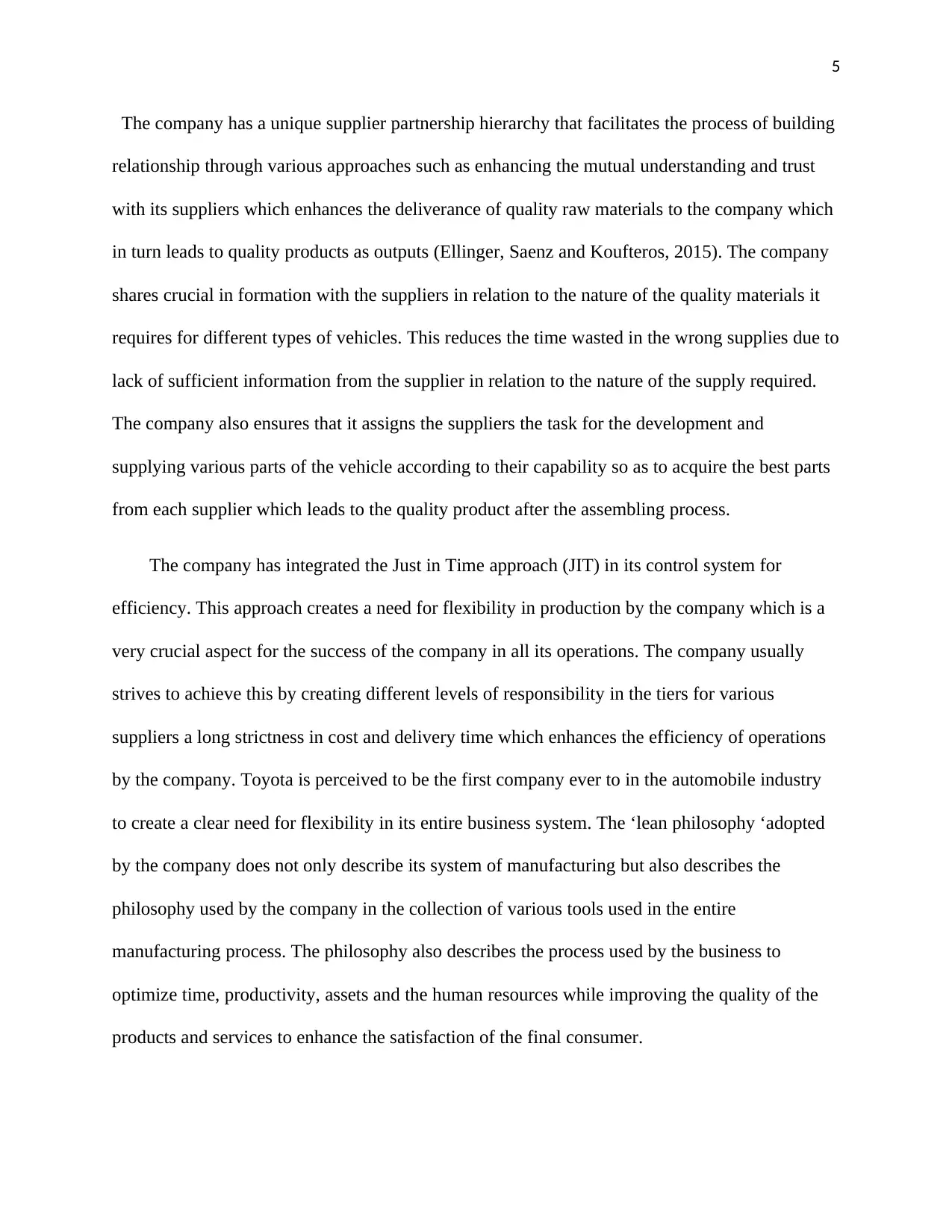
5
The company has a unique supplier partnership hierarchy that facilitates the process of building
relationship through various approaches such as enhancing the mutual understanding and trust
with its suppliers which enhances the deliverance of quality raw materials to the company which
in turn leads to quality products as outputs (Ellinger, Saenz and Koufteros, 2015). The company
shares crucial in formation with the suppliers in relation to the nature of the quality materials it
requires for different types of vehicles. This reduces the time wasted in the wrong supplies due to
lack of sufficient information from the supplier in relation to the nature of the supply required.
The company also ensures that it assigns the suppliers the task for the development and
supplying various parts of the vehicle according to their capability so as to acquire the best parts
from each supplier which leads to the quality product after the assembling process.
The company has integrated the Just in Time approach (JIT) in its control system for
efficiency. This approach creates a need for flexibility in production by the company which is a
very crucial aspect for the success of the company in all its operations. The company usually
strives to achieve this by creating different levels of responsibility in the tiers for various
suppliers a long strictness in cost and delivery time which enhances the efficiency of operations
by the company. Toyota is perceived to be the first company ever to in the automobile industry
to create a clear need for flexibility in its entire business system. The ‘lean philosophy ‘adopted
by the company does not only describe its system of manufacturing but also describes the
philosophy used by the company in the collection of various tools used in the entire
manufacturing process. The philosophy also describes the process used by the business to
optimize time, productivity, assets and the human resources while improving the quality of the
products and services to enhance the satisfaction of the final consumer.
The company has a unique supplier partnership hierarchy that facilitates the process of building
relationship through various approaches such as enhancing the mutual understanding and trust
with its suppliers which enhances the deliverance of quality raw materials to the company which
in turn leads to quality products as outputs (Ellinger, Saenz and Koufteros, 2015). The company
shares crucial in formation with the suppliers in relation to the nature of the quality materials it
requires for different types of vehicles. This reduces the time wasted in the wrong supplies due to
lack of sufficient information from the supplier in relation to the nature of the supply required.
The company also ensures that it assigns the suppliers the task for the development and
supplying various parts of the vehicle according to their capability so as to acquire the best parts
from each supplier which leads to the quality product after the assembling process.
The company has integrated the Just in Time approach (JIT) in its control system for
efficiency. This approach creates a need for flexibility in production by the company which is a
very crucial aspect for the success of the company in all its operations. The company usually
strives to achieve this by creating different levels of responsibility in the tiers for various
suppliers a long strictness in cost and delivery time which enhances the efficiency of operations
by the company. Toyota is perceived to be the first company ever to in the automobile industry
to create a clear need for flexibility in its entire business system. The ‘lean philosophy ‘adopted
by the company does not only describe its system of manufacturing but also describes the
philosophy used by the company in the collection of various tools used in the entire
manufacturing process. The philosophy also describes the process used by the business to
optimize time, productivity, assets and the human resources while improving the quality of the
products and services to enhance the satisfaction of the final consumer.
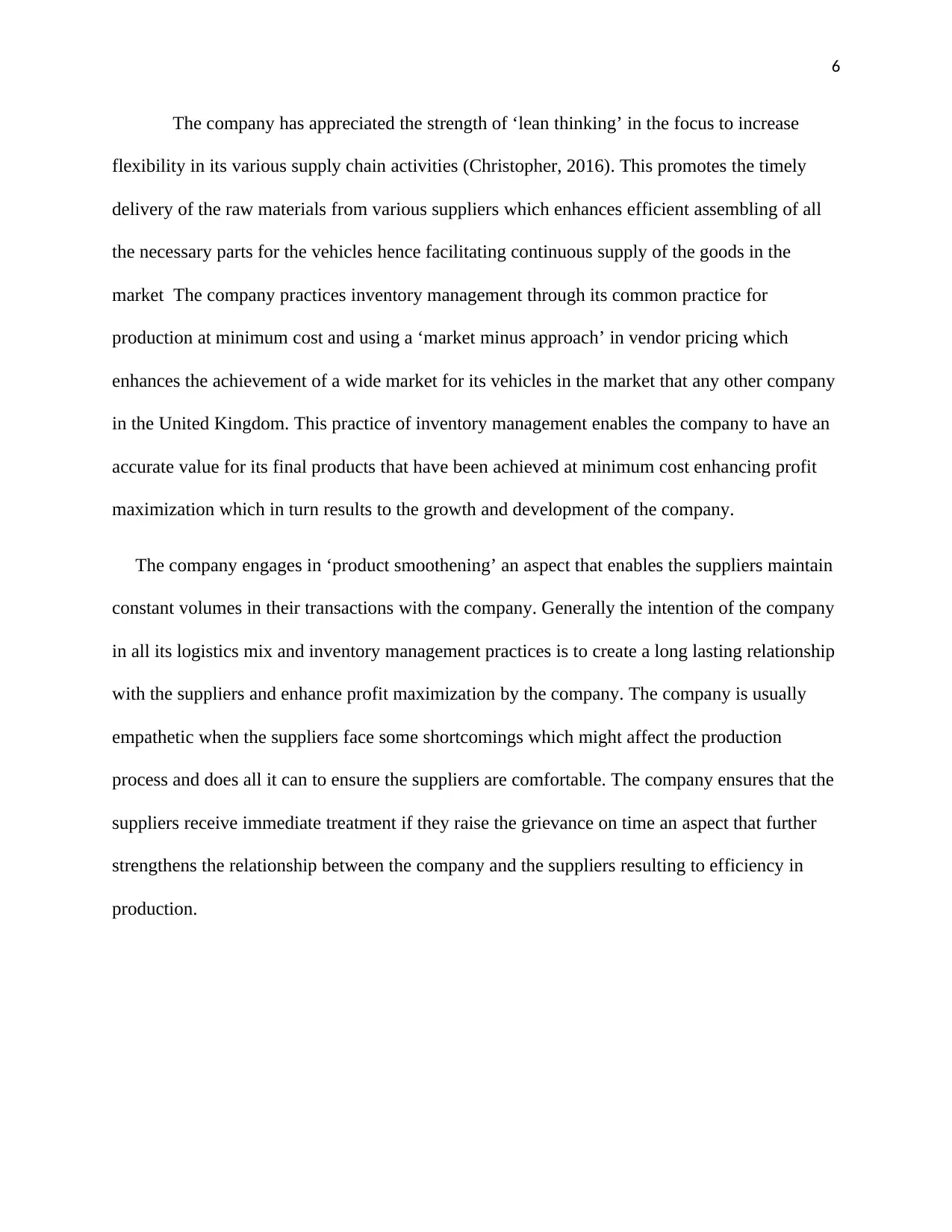
6
The company has appreciated the strength of ‘lean thinking’ in the focus to increase
flexibility in its various supply chain activities (Christopher, 2016). This promotes the timely
delivery of the raw materials from various suppliers which enhances efficient assembling of all
the necessary parts for the vehicles hence facilitating continuous supply of the goods in the
market The company practices inventory management through its common practice for
production at minimum cost and using a ‘market minus approach’ in vendor pricing which
enhances the achievement of a wide market for its vehicles in the market that any other company
in the United Kingdom. This practice of inventory management enables the company to have an
accurate value for its final products that have been achieved at minimum cost enhancing profit
maximization which in turn results to the growth and development of the company.
The company engages in ‘product smoothening’ an aspect that enables the suppliers maintain
constant volumes in their transactions with the company. Generally the intention of the company
in all its logistics mix and inventory management practices is to create a long lasting relationship
with the suppliers and enhance profit maximization by the company. The company is usually
empathetic when the suppliers face some shortcomings which might affect the production
process and does all it can to ensure the suppliers are comfortable. The company ensures that the
suppliers receive immediate treatment if they raise the grievance on time an aspect that further
strengthens the relationship between the company and the suppliers resulting to efficiency in
production.
The company has appreciated the strength of ‘lean thinking’ in the focus to increase
flexibility in its various supply chain activities (Christopher, 2016). This promotes the timely
delivery of the raw materials from various suppliers which enhances efficient assembling of all
the necessary parts for the vehicles hence facilitating continuous supply of the goods in the
market The company practices inventory management through its common practice for
production at minimum cost and using a ‘market minus approach’ in vendor pricing which
enhances the achievement of a wide market for its vehicles in the market that any other company
in the United Kingdom. This practice of inventory management enables the company to have an
accurate value for its final products that have been achieved at minimum cost enhancing profit
maximization which in turn results to the growth and development of the company.
The company engages in ‘product smoothening’ an aspect that enables the suppliers maintain
constant volumes in their transactions with the company. Generally the intention of the company
in all its logistics mix and inventory management practices is to create a long lasting relationship
with the suppliers and enhance profit maximization by the company. The company is usually
empathetic when the suppliers face some shortcomings which might affect the production
process and does all it can to ensure the suppliers are comfortable. The company ensures that the
suppliers receive immediate treatment if they raise the grievance on time an aspect that further
strengthens the relationship between the company and the suppliers resulting to efficiency in
production.
⊘ This is a preview!⊘
Do you want full access?
Subscribe today to unlock all pages.

Trusted by 1+ million students worldwide
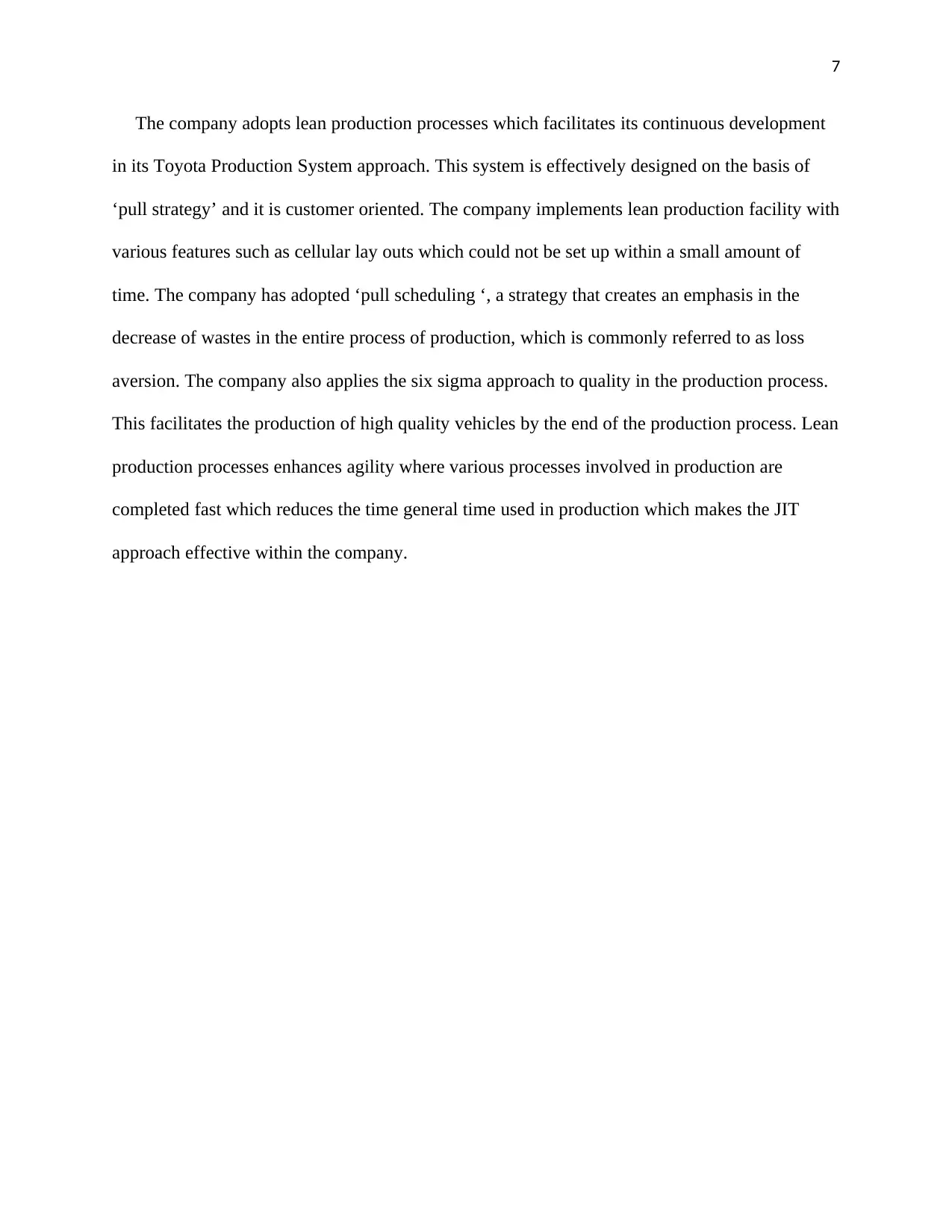
7
The company adopts lean production processes which facilitates its continuous development
in its Toyota Production System approach. This system is effectively designed on the basis of
‘pull strategy’ and it is customer oriented. The company implements lean production facility with
various features such as cellular lay outs which could not be set up within a small amount of
time. The company has adopted ‘pull scheduling ‘, a strategy that creates an emphasis in the
decrease of wastes in the entire process of production, which is commonly referred to as loss
aversion. The company also applies the six sigma approach to quality in the production process.
This facilitates the production of high quality vehicles by the end of the production process. Lean
production processes enhances agility where various processes involved in production are
completed fast which reduces the time general time used in production which makes the JIT
approach effective within the company.
The company adopts lean production processes which facilitates its continuous development
in its Toyota Production System approach. This system is effectively designed on the basis of
‘pull strategy’ and it is customer oriented. The company implements lean production facility with
various features such as cellular lay outs which could not be set up within a small amount of
time. The company has adopted ‘pull scheduling ‘, a strategy that creates an emphasis in the
decrease of wastes in the entire process of production, which is commonly referred to as loss
aversion. The company also applies the six sigma approach to quality in the production process.
This facilitates the production of high quality vehicles by the end of the production process. Lean
production processes enhances agility where various processes involved in production are
completed fast which reduces the time general time used in production which makes the JIT
approach effective within the company.
Paraphrase This Document
Need a fresh take? Get an instant paraphrase of this document with our AI Paraphraser
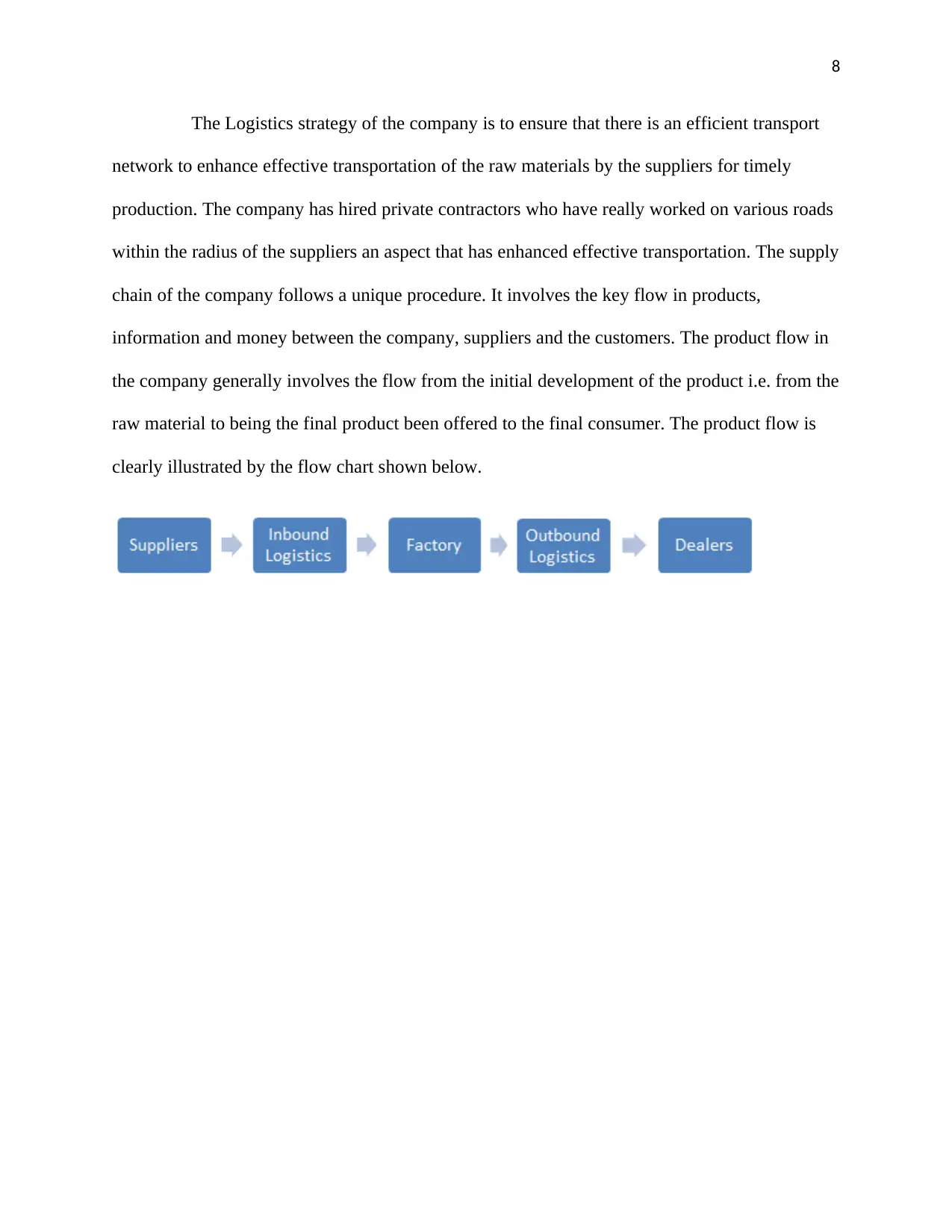
8
The Logistics strategy of the company is to ensure that there is an efficient transport
network to enhance effective transportation of the raw materials by the suppliers for timely
production. The company has hired private contractors who have really worked on various roads
within the radius of the suppliers an aspect that has enhanced effective transportation. The supply
chain of the company follows a unique procedure. It involves the key flow in products,
information and money between the company, suppliers and the customers. The product flow in
the company generally involves the flow from the initial development of the product i.e. from the
raw material to being the final product been offered to the final consumer. The product flow is
clearly illustrated by the flow chart shown below.
The Logistics strategy of the company is to ensure that there is an efficient transport
network to enhance effective transportation of the raw materials by the suppliers for timely
production. The company has hired private contractors who have really worked on various roads
within the radius of the suppliers an aspect that has enhanced effective transportation. The supply
chain of the company follows a unique procedure. It involves the key flow in products,
information and money between the company, suppliers and the customers. The product flow in
the company generally involves the flow from the initial development of the product i.e. from the
raw material to being the final product been offered to the final consumer. The product flow is
clearly illustrated by the flow chart shown below.
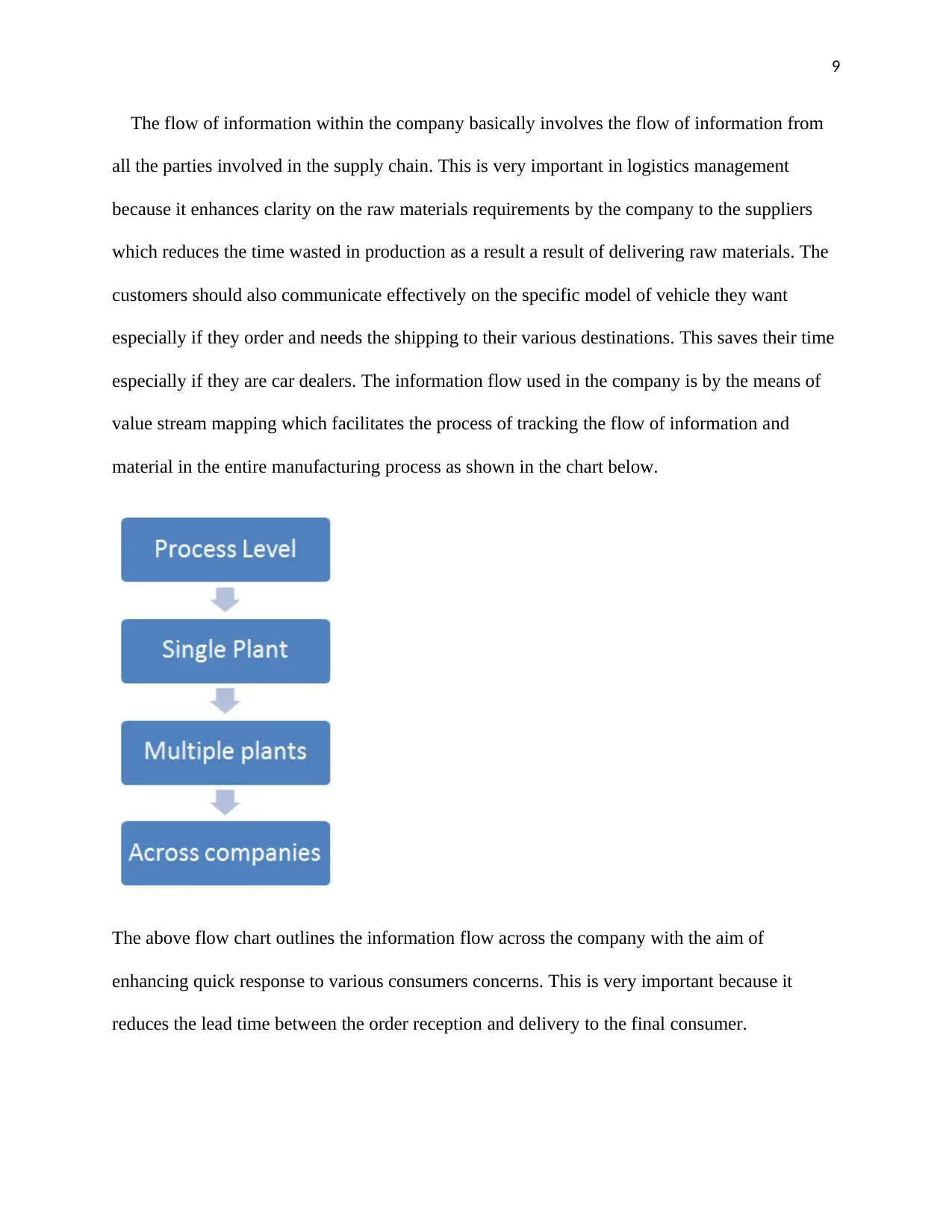
9
The flow of information within the company basically involves the flow of information from
all the parties involved in the supply chain. This is very important in logistics management
because it enhances clarity on the raw materials requirements by the company to the suppliers
which reduces the time wasted in production as a result a result of delivering raw materials. The
customers should also communicate effectively on the specific model of vehicle they want
especially if they order and needs the shipping to their various destinations. This saves their time
especially if they are car dealers. The information flow used in the company is by the means of
value stream mapping which facilitates the process of tracking the flow of information and
material in the entire manufacturing process as shown in the chart below.
The above flow chart outlines the information flow across the company with the aim of
enhancing quick response to various consumers concerns. This is very important because it
reduces the lead time between the order reception and delivery to the final consumer.
The flow of information within the company basically involves the flow of information from
all the parties involved in the supply chain. This is very important in logistics management
because it enhances clarity on the raw materials requirements by the company to the suppliers
which reduces the time wasted in production as a result a result of delivering raw materials. The
customers should also communicate effectively on the specific model of vehicle they want
especially if they order and needs the shipping to their various destinations. This saves their time
especially if they are car dealers. The information flow used in the company is by the means of
value stream mapping which facilitates the process of tracking the flow of information and
material in the entire manufacturing process as shown in the chart below.
The above flow chart outlines the information flow across the company with the aim of
enhancing quick response to various consumers concerns. This is very important because it
reduces the lead time between the order reception and delivery to the final consumer.
⊘ This is a preview!⊘
Do you want full access?
Subscribe today to unlock all pages.

Trusted by 1+ million students worldwide
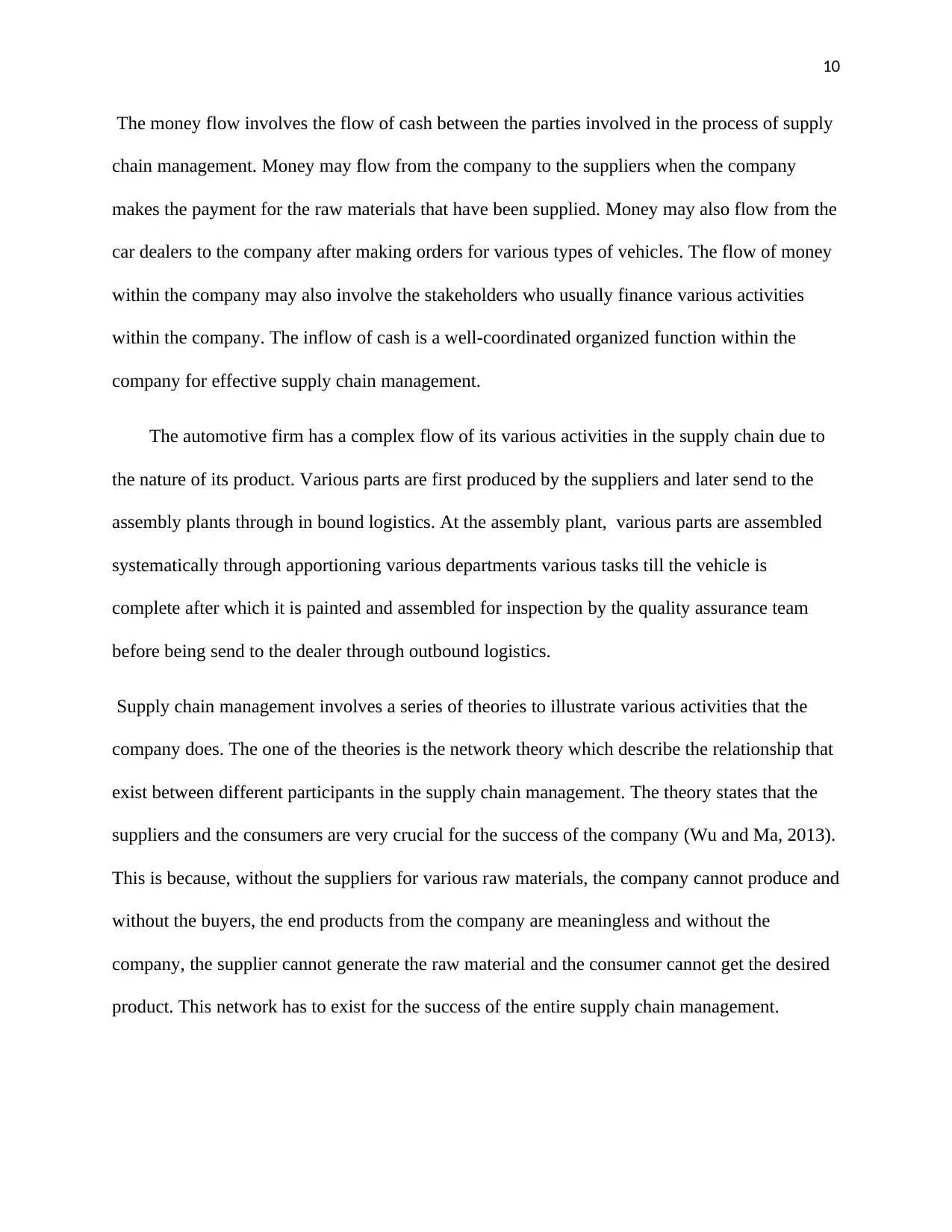
10
The money flow involves the flow of cash between the parties involved in the process of supply
chain management. Money may flow from the company to the suppliers when the company
makes the payment for the raw materials that have been supplied. Money may also flow from the
car dealers to the company after making orders for various types of vehicles. The flow of money
within the company may also involve the stakeholders who usually finance various activities
within the company. The inflow of cash is a well-coordinated organized function within the
company for effective supply chain management.
The automotive firm has a complex flow of its various activities in the supply chain due to
the nature of its product. Various parts are first produced by the suppliers and later send to the
assembly plants through in bound logistics. At the assembly plant, various parts are assembled
systematically through apportioning various departments various tasks till the vehicle is
complete after which it is painted and assembled for inspection by the quality assurance team
before being send to the dealer through outbound logistics.
Supply chain management involves a series of theories to illustrate various activities that the
company does. The one of the theories is the network theory which describe the relationship that
exist between different participants in the supply chain management. The theory states that the
suppliers and the consumers are very crucial for the success of the company (Wu and Ma, 2013).
This is because, without the suppliers for various raw materials, the company cannot produce and
without the buyers, the end products from the company are meaningless and without the
company, the supplier cannot generate the raw material and the consumer cannot get the desired
product. This network has to exist for the success of the entire supply chain management.
The money flow involves the flow of cash between the parties involved in the process of supply
chain management. Money may flow from the company to the suppliers when the company
makes the payment for the raw materials that have been supplied. Money may also flow from the
car dealers to the company after making orders for various types of vehicles. The flow of money
within the company may also involve the stakeholders who usually finance various activities
within the company. The inflow of cash is a well-coordinated organized function within the
company for effective supply chain management.
The automotive firm has a complex flow of its various activities in the supply chain due to
the nature of its product. Various parts are first produced by the suppliers and later send to the
assembly plants through in bound logistics. At the assembly plant, various parts are assembled
systematically through apportioning various departments various tasks till the vehicle is
complete after which it is painted and assembled for inspection by the quality assurance team
before being send to the dealer through outbound logistics.
Supply chain management involves a series of theories to illustrate various activities that the
company does. The one of the theories is the network theory which describe the relationship that
exist between different participants in the supply chain management. The theory states that the
suppliers and the consumers are very crucial for the success of the company (Wu and Ma, 2013).
This is because, without the suppliers for various raw materials, the company cannot produce and
without the buyers, the end products from the company are meaningless and without the
company, the supplier cannot generate the raw material and the consumer cannot get the desired
product. This network has to exist for the success of the entire supply chain management.
Paraphrase This Document
Need a fresh take? Get an instant paraphrase of this document with our AI Paraphraser

11
Agency theory is another significant theory in supply chain management. The theory is
built on the foundation of delegation of duties between various parties involved in the process of
supply chain management (Whipple and Roh, 2010). The company delegates the responsibility
for supply of raw materials to the suppliers who commit themselves to ensure timely delivery to
initiate continuity in the process of production. The dealer might award the company a contract
for the manufacture of specific models of the vehicles an aspect that enhances the commitment
of the company in the production of the vehicles as per the dealers’ specifications.
Agency theory is another significant theory in supply chain management. The theory is
built on the foundation of delegation of duties between various parties involved in the process of
supply chain management (Whipple and Roh, 2010). The company delegates the responsibility
for supply of raw materials to the suppliers who commit themselves to ensure timely delivery to
initiate continuity in the process of production. The dealer might award the company a contract
for the manufacture of specific models of the vehicles an aspect that enhances the commitment
of the company in the production of the vehicles as per the dealers’ specifications.
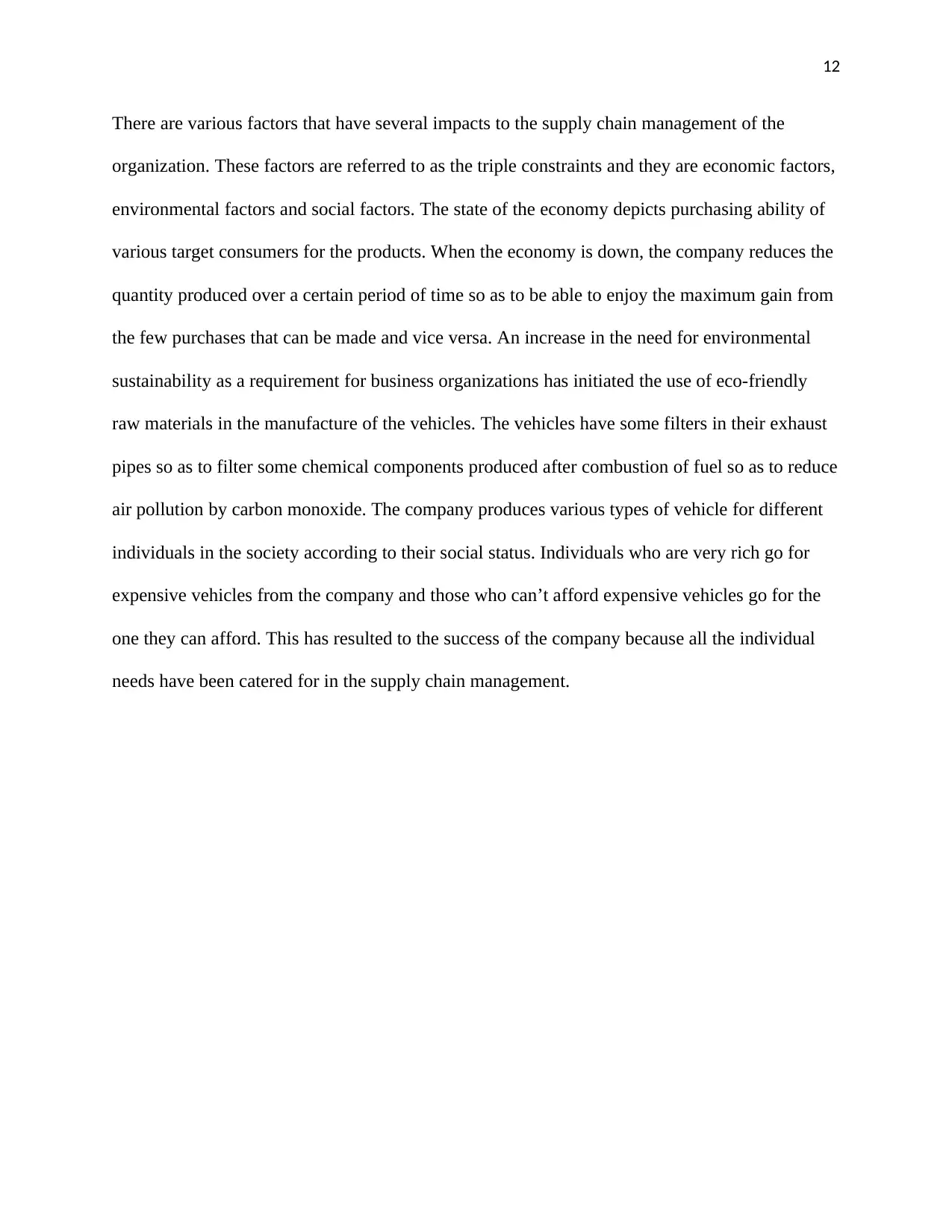
12
There are various factors that have several impacts to the supply chain management of the
organization. These factors are referred to as the triple constraints and they are economic factors,
environmental factors and social factors. The state of the economy depicts purchasing ability of
various target consumers for the products. When the economy is down, the company reduces the
quantity produced over a certain period of time so as to be able to enjoy the maximum gain from
the few purchases that can be made and vice versa. An increase in the need for environmental
sustainability as a requirement for business organizations has initiated the use of eco-friendly
raw materials in the manufacture of the vehicles. The vehicles have some filters in their exhaust
pipes so as to filter some chemical components produced after combustion of fuel so as to reduce
air pollution by carbon monoxide. The company produces various types of vehicle for different
individuals in the society according to their social status. Individuals who are very rich go for
expensive vehicles from the company and those who can’t afford expensive vehicles go for the
one they can afford. This has resulted to the success of the company because all the individual
needs have been catered for in the supply chain management.
There are various factors that have several impacts to the supply chain management of the
organization. These factors are referred to as the triple constraints and they are economic factors,
environmental factors and social factors. The state of the economy depicts purchasing ability of
various target consumers for the products. When the economy is down, the company reduces the
quantity produced over a certain period of time so as to be able to enjoy the maximum gain from
the few purchases that can be made and vice versa. An increase in the need for environmental
sustainability as a requirement for business organizations has initiated the use of eco-friendly
raw materials in the manufacture of the vehicles. The vehicles have some filters in their exhaust
pipes so as to filter some chemical components produced after combustion of fuel so as to reduce
air pollution by carbon monoxide. The company produces various types of vehicle for different
individuals in the society according to their social status. Individuals who are very rich go for
expensive vehicles from the company and those who can’t afford expensive vehicles go for the
one they can afford. This has resulted to the success of the company because all the individual
needs have been catered for in the supply chain management.
⊘ This is a preview!⊘
Do you want full access?
Subscribe today to unlock all pages.

Trusted by 1+ million students worldwide
1 out of 16
Related Documents
Your All-in-One AI-Powered Toolkit for Academic Success.
+13062052269
info@desklib.com
Available 24*7 on WhatsApp / Email
![[object Object]](/_next/static/media/star-bottom.7253800d.svg)
Unlock your academic potential
Copyright © 2020–2025 A2Z Services. All Rights Reserved. Developed and managed by ZUCOL.





